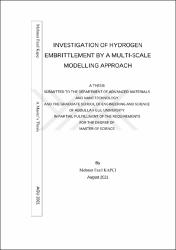| dc.contributor.author | KAPÇI, Mehmet Fazıl | |
| dc.date.accessioned | 2022-03-11T09:06:20Z | |
| dc.date.available | 2022-03-11T09:06:20Z | |
| dc.date.issued | 2021 | en_US |
| dc.date.submitted | 2021-08 | |
| dc.identifier.uri | https://hdl.handle.net/20.500.12573/1248 | |
| dc.description.abstract | Hydrogen exposure of metallic materials during their service times or during the
application of processes e.g. machining, welding, electroplating leads to degradation of
the mechanical properties which is a phenomenon known as hydrogen embrittlement.
Diffused hydrogen into metal can accumulate in crystal defects and alter the mechanical
behavior under loading. In this thesis, diffusion of the hydrogen as well as the atomistic
mechanisms of dislocation mobility depending on the presence of hydrogen were
investigated for two edge dislocation systems that are active in the plasticity of α-Fe,
specifically ½<111>{110} and ½<111>{112}. In particular, the glide of the dislocation
pile-ups through a single crystal, as well as transmission of the pile-ups across the grain
boundary were evaluated in bcc iron crystals that contain hydrogen concentrations in
different amounts. Additionally, the uniaxial tensile response under a constant strain
rate was analyzed for the aforementioned structures. Lastly, diffusion and backdiffusion of the hydrogen into bcc, fcc, and hcp crystal structures were investigated with
numerical models. The results reveal that the presence of hydrogen decreases the
velocity of the dislocations – in contrast to the commonly invoked HELP (Hydrogenenhanced localized plasticity) mechanism -, although some localization was observed
near the grain boundary where dislocations were pinned by elastic stress fields. In the
presence of pre-exisiting dislocations, hydrogen-induced hardening was observed as a
consequence of the restriction of the dislocation mobility under uniaxial tension.
Furthermore, it was observed that hydrogen accumulation in the grain boundary
suppresses the formation of new grains that leads to a hardening response in the stressstrain behaviour which can initiate brittle fracture points | en_US |
| dc.language.iso | eng | en_US |
| dc.publisher | Abdullah Gül Üniversitesi, Fen Bilimleri Enstitüsü | en_US |
| dc.rights | info:eu-repo/semantics/openAccess | en_US |
| dc.subject | Hydrogen Embrittlement | en_US |
| dc.subject | Molecular Dynamics | en_US |
| dc.subject | Dislocation | en_US |
| dc.subject | Fracture | en_US |
| dc.title | INVESTIGATION OF HYDROGEN EMBRITTLEMENT BY A MULTI-SCALE MODELLING APPROACH | en_US |
| dc.type | masterThesis | en_US |
| dc.contributor.department | AGÜ, Fen Bilimleri Enstitüsü, İleri Malzemeler ve Nanoteknoloji Ana Bilim Dalı | en_US |
| dc.relation.publicationcategory | Tez | en_US |


















